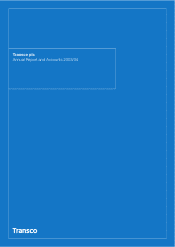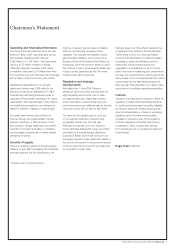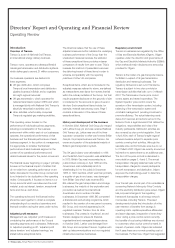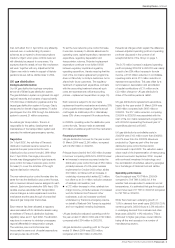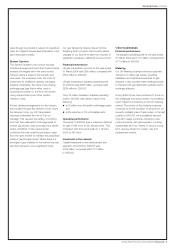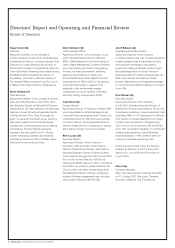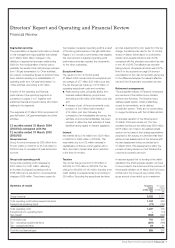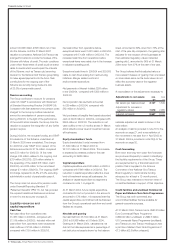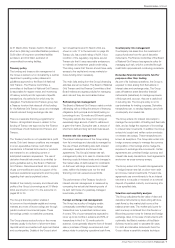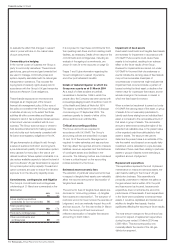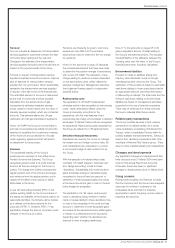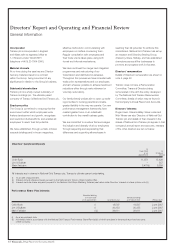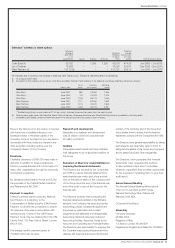National Grid 2004 Annual Report Download - page 5
Download and view the complete annual report
Please find page 5 of the 2004 National Grid annual report below. You can navigate through the pages in the report by either clicking on the pages listed below, or by using the keyword search tool below to find specific information within the annual report.
Annual Report and Accounts 2003/04_Transco plc 3
Operating Review_continued
that, with effect from 1 April 2002, any efficiently
incurred over or underfunding of pension
schemes as compared to those assumptions
made by Ofgem when price controls were set,
will ultimately be passed to consumers. It is
expected that the details of how this mechanism
will work, together with any adjustments that
Ofgem may wish to make in respect of historic
pensions issues, will be clarified later in 2004.
UK gas distribution
Background information
Our UK gas distribution business comprises
almost all of Britain’s gas distribution system.
The gas distribution system is organised into eight
regional networks and consists of approximately
170,000 miles of distribution pipelines and is the
largest gas distribution system in Europe. Gas is
transported on behalf of approximately 70 active
gas shippers from the NTS through the distribution
system to around 21 million consumers.
As well as gas transportation, Transco is
responsible for the safety, development and
maintenance of the transportation system and
operates the national gas emergency service.
Regulation
On 1 April 2002, the activities of Transco’s
distribution business became subject to a
separate five-year price control formula
(‘distribution price control formula’). With effect
from 1 April 2004, this single price control
formula was disaggregated into eight separate
price control formulae (‘networks price control
formulae’) to cover the activities of the eight
regional distribution networks.
The new networks price control formulae take the
same form as the distribution price control formula,
with a maximum allowed revenue assigned to each
network. Each formula retains the 65% fixed, 35%
variable revenue associated with transportation
volume changes, a mains replacement incentive
mechanism and the pass through of prescribed
rates and gas transporter licence fees.
Each network has been allocated a regulatory
value associated with its distribution assets, using
an estimate of Transco’s distribution business
regulatory value as at 1 April 2002. The allocation
was done in a manner to minimise unnecessary
regional differentials in transportation charges.
The networks price control formulae also
incorporate the same cost of capital assumptions
at a real pre-tax rate of 6.25%.
To set the new networks price control formulae
it was also necessary to allocate allowances for
operating costs, capital expenditure, replacement
expenditure, regulatory depreciation and
transportation volumes. Projected replacement
expenditure continues to be divided 50:50
between regulatory capital and regulatory
operating expenditure, thereby ensuring that the
cost of the iron mains replacement programme
does not fall wholly on today’s customers, but is
shared with future customers. The regulatory
treatment of replacement expenditure contrasts
with the accounting treatment where all such
costs are expensed (see critical accounting
policies – replacement expenditure on page 10).
Each network is subject to its own mains
replacement incentive mechanism and retains 33%
of any outperformance against Ofgem’s annual
cost targets as additional profit, or alternatively,
bears 50% of any overspend if it under-performs.
In 2003/04, operating under the distribution price
control formula, Transco made an estimated
£10 million of additional profit from this mechanism.
Financial performance
UK gas distribution turnover for the year ended
31 March 2004 was £2,245 million, compared
with £2,089 million in 2002/03.
Principal factors behind the £156 million increase
in turnover comparing 2003/04 to 2002/03 were:
an increase in revenue recovered under the
distribution price control formula of £84 million,
primarily because of a 5% price increase
implemented in October 2003 which added
£79 million, combined with an increase in
underlying volumes which added £21 million,
but offset by an £11 million reduction because
of relatively mild weather; and
a £72 million increase in other, relatively low
margin income, primarily because of increased
work for National Grid Transco’s other
businesses, such as increased workload
undertaken by Transco’s emergency service
on behalf of National Grid Transco’s regulated
and non-regulated metering businesses.
UK gas distribution adjusted operating profit for
the year ended 31 March 2004 was £729 million,
compared with £554 million in 2002/03.
UK gas distribution operating profit for the year
ended 31 March 2004 was £653 million,
compared with £443 million in 2002/03.
Exceptional charges which explain the difference
between adjusted operating profit and operating
profit are discussed in the context of all
exceptional items of the Group on page 7.
The £175 million increase in adjusted operating
profit comparing 2003/04 to 2002/03 was mainly
a result of an £84 million increase in formula
income, a £103 million reduction in controllable
operating costs and a £17 million reduction in
replacement expenditure. This was offset by a
net increase in depreciation and amortisation
of capital contributions of £11 million and a
£23 million charge for UK gas distribution’s
share of the Lattice pensions deficit.
UK gas distribution’s replacement expenditure
(repex) for the year ended 31 March 2004 was
£388 million compared with £405 million in
2002/03. The £17 million reduction comparing
2003/04 to 2002/03 was associated with the
start of the iron mains replacement programme
with 2003/04 representing the lowest year of
expenditure planned until 2007.
UK gas distribution’s controllable costs in
2003/04 were £103 million lower than 2002/03
and 7% lower than the 2003/04 allowance
projected by Ofgem as part of the five-year
distribution price control formula which
commenced in April 2002. The reduction was a
direct result of the implementation of restructuring
plans announced in September 2002, coupled
with continued investment in technology, and
the centralisation of activities, aided by synergies
from the Merger of National Grid and Lattice.
Operating performance
Gas throughput was 706 TWh in 2003/04
compared to 708 TWh in 2002/03. If the
weather had corresponded to seasonal normal
temperatures, it is estimated that gas throughput
would have been 731 TWh in 2003/04 compared
to 730 TWh in 2002/03.
While there has been underlying growth of
1.9% in demand from small users (2002/03 2.0%
demand growth), 2003/04 saw a 3.5% reduction
in underlying demand from business and other
large users (2002/03 1.6% reduction). This is
attributed to higher gas prices, power stations
being off-line and recession in a number of
manufacturing sectors.

